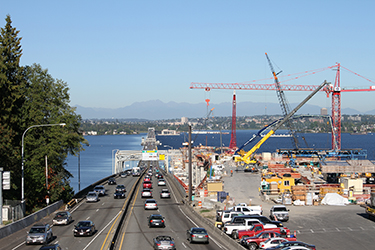|
Subscribe / Renew |
|
|
Contact Us |
|
| ► Subscribe to our Free Weekly Newsletter | |
| home | Welcome, sign in or click here to subscribe. | login |
Environment
| |
 |
September 24, 2015
Survey: Shannon & Wilson
Specialty: Geotechnical and environmental engineering
Management: Gerard Buechel, president
Founded: 1954
Headquarters: Seattle
2014 revenues: $61.7 million
Projected 2015 revenues: N/A
Projects: Fir Island estuary restoration; Alaskan Way Viaduct replacement program; SR 520 Bridge replacement and HOV program; Sound Transit East Link E320; JBLM interchange justification report
The DJC asked Shannon & Wilson vice presidents Katie Walters and Dave Cline about their company.
Q: What types of projects is the firm working on?
Walters: Shannon & Wilson continues our focus on public sector work. We have several large ongoing projects for WSDOT, Sound Transit and BNSF. In addition to those infrastructure projects, our water resources group is working on several projects that involve levee setbacks for habitat and shoreline restoration using funding that is related to salmon enhancement grants.
Q: How has technology changed what you do?
Cline: Advances in geospatial technology combined with the ability to integrate soil, groundwater and surface water numerical modeling has created more opportunities to provide integrated environmental and infrastructure studies and designs to our clients. These technologies also provide visual output that improves our ability to communicate complex scientific information to our clients and their project partners.
Q: What markets are you entering or exiting?
Cline: We believe that our geology, geotechnical, water resources, environmental and natural resources services are well suited to provide solutions for climate change and sea level rise related issues including river and coastal flooding, salt water intrusion, landslides and drought.
Q: What is the most difficult project your firm recently worked on?
Cline: We had the opportunity to be the lead for design and permits on the Washington State Department of Fish & Wildlife’s Fir Island Farms estuary restoration project.
The project involved feasibility, design, permitting and stakeholder outreach for a mile-long levee setback, drainage improvements and 130-acre tidal marsh and estuary restoration. A key challenge was completing an expedited design and permit schedule in an 18-month period involving multiple stakeholders, technical advisory committee and regulatory agency reviews, to dovetail with construction grant funding available in 2015-16.
The construction of the levee setback and drainage infrastructure is near completion in 2015, and the project is on schedule for levee removal and marsh restoration in 2016.
Q: What is your outlook for the Seattle area?
Walters: We are very optimistic about the next couple of years. Passage of the state transportation package and local transportation budgets has created a lot of opportunity for road and other infrastructure projects at both the state and local level. We have historically done a lot of public sector work and have already seen a lot of projects moving into design and construction as a result of these new budgets.
Other Stories:
- LID development training is a game changer here
- Survey: Ridolfi
- Survey: Climate Solutions
- Survey: O’Brien & Co.
- Survey: Cascadia Consulting Group
- Survey: Golder Associates
- How deep green buildings can educate kids
- Here’s how to improve environmental health and safety
- New Ecology cleanup guidance: mirage or oasis?
- Kirkland taps county’s purple pipes for recycled water
- Drought heats up battle over water rights
- Designing infrastructure to combat climate change
- Building green? Don’t forget green financing
- Survey: Innovex Environmental Management



